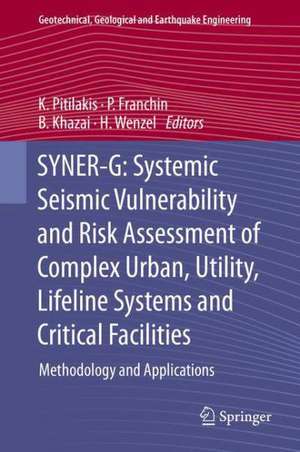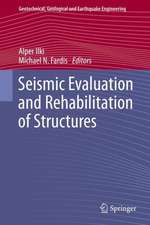SYNER-G: Systemic Seismic Vulnerability and Risk Assessment of Complex Urban, Utility, Lifeline Systems and Critical Facilities: Methodology and Applications: Geotechnical, Geological and Earthquake Engineering, cartea 31
Editat de K. Pitilakis, P. Franchin, B. Khazai, H. Wenzelen Limba Engleză Hardback – 9 iul 2014
In this second volume of SYNER-G, the focus has been on presenting a unified holistic methodology for assessing vulnerability at systems level considering interactions between elements at risk (physical and non-physical) and between different systems. The proposed methodology and tool encompasses in an integrated fashion all aspects in the chain, from hazard to the vulnerability assessment of components and systems and to the socio-economic impacts of an earthquake, accounting for most relevant uncertainties within an efficient quantitative simulation scheme. It systematically integrates the most advanced fragility functions to assess the vulnerability of physical assets for buildings, utility systems, transportation networks and complex infrastructures such as harbours and hospitals. The increasing impact due to interactions between different components and systems is treated in a comprehensive way, providing specifications for each network and infrastructure. The proposed socio-economic model integrates social vulnerability into the physical systems modelling approaches providing to decision makers with a dynamic platform to capture post disaster emergency issues like shelter demand and health impact decisions. Application examples at city and regional scale have provided thenecessary validation of the methodology and are also included in the book.
The present volume, with its companion volume on fragility functions, represent a significant step forward in the seismic vulnerability and risk assessment of complex interacting urban and regional systems and infrastructures. These volumes are not only of interest to scientists and engineers but also to the insurance industry, decision makers and practitioners in the sector of civil protection and seismic risk management.
(*) Pitilakis K, Crowley E, Kaynia A (eds) (2014) SYNER-G: Typology definition and fragility functions for physical elements at seismic risk, Series: Geotechnical, Geological and Earthquake Engineering 27, ISBN 978-94-007-7872-6, Springer Science+Business Media, Dordrecht.
Din seria Geotechnical, Geological and Earthquake Engineering
- 15%
 Preț: 640.03 lei
Preț: 640.03 lei - 18%
 Preț: 1351.11 lei
Preț: 1351.11 lei - 15%
 Preț: 689.85 lei
Preț: 689.85 lei - 18%
 Preț: 921.95 lei
Preț: 921.95 lei - 15%
 Preț: 631.08 lei
Preț: 631.08 lei - 18%
 Preț: 1868.21 lei
Preț: 1868.21 lei -
 Preț: 377.68 lei
Preț: 377.68 lei - 18%
 Preț: 917.56 lei
Preț: 917.56 lei - 18%
 Preț: 917.40 lei
Preț: 917.40 lei - 15%
 Preț: 613.62 lei
Preț: 613.62 lei - 18%
 Preț: 917.40 lei
Preț: 917.40 lei - 15%
 Preț: 615.52 lei
Preț: 615.52 lei - 20%
 Preț: 619.74 lei
Preț: 619.74 lei - 24%
 Preț: 871.66 lei
Preț: 871.66 lei - 20%
 Preț: 652.35 lei
Preț: 652.35 lei - 15%
 Preț: 614.41 lei
Preț: 614.41 lei - 18%
 Preț: 1194.47 lei
Preț: 1194.47 lei - 15%
 Preț: 615.05 lei
Preț: 615.05 lei - 15%
 Preț: 612.85 lei
Preț: 612.85 lei - 18%
 Preț: 1174.45 lei
Preț: 1174.45 lei - 18%
 Preț: 929.54 lei
Preț: 929.54 lei - 18%
 Preț: 922.72 lei
Preț: 922.72 lei - 15%
 Preț: 633.43 lei
Preț: 633.43 lei - 18%
 Preț: 931.81 lei
Preț: 931.81 lei - 15%
 Preț: 628.56 lei
Preț: 628.56 lei - 15%
 Preț: 632.33 lei
Preț: 632.33 lei - 18%
 Preț: 924.22 lei
Preț: 924.22 lei - 18%
 Preț: 924.52 lei
Preț: 924.52 lei - 15%
 Preț: 624.01 lei
Preț: 624.01 lei -
 Preț: 432.86 lei
Preț: 432.86 lei - 18%
 Preț: 929.67 lei
Preț: 929.67 lei - 18%
 Preț: 1074.51 lei
Preț: 1074.51 lei - 15%
 Preț: 631.23 lei
Preț: 631.23 lei
Preț: 627.31 lei
Preț vechi: 738.01 lei
-15% Nou
Puncte Express: 941
Preț estimativ în valută:
111.01€ • 129.45$ • 97.47£
111.01€ • 129.45$ • 97.47£
Carte tipărită la comandă
Livrare economică 16-30 ianuarie 26
Preluare comenzi: 021 569.72.76
Specificații
ISBN-13: 9789401788342
ISBN-10: 9401788340
Pagini: 412
Ilustrații: XXVI, 384 p. 194 illus., 91 illus. in color.
Dimensiuni: 155 x 235 x 30 mm
Greutate: 0.75 kg
Ediția:2014
Editura: SPRINGER NETHERLANDS
Colecția Springer
Seria Geotechnical, Geological and Earthquake Engineering
Locul publicării:Dordrecht, Netherlands
ISBN-10: 9401788340
Pagini: 412
Ilustrații: XXVI, 384 p. 194 illus., 91 illus. in color.
Dimensiuni: 155 x 235 x 30 mm
Greutate: 0.75 kg
Ediția:2014
Editura: SPRINGER NETHERLANDS
Colecția Springer
Seria Geotechnical, Geological and Earthquake Engineering
Locul publicării:Dordrecht, Netherlands
Public țintă
ResearchCuprins
Introduction.- A Computational Framework for Systemic Seismic Risk Analysis of Civil Infrastructural Systems.- Framework for Seismic Hazard Analysis of Spatially Distributed Systems.- Framework for Systemic Socio-Economic Vulnerability and Loss Assessment.- Specification of the Vulnerability of Physical Systems.- Introduction to the Applications of the SYNER-G Methodology and Tools.- Application to the City of Thessaloniki.- Application to the City of Vienna.- Application to L’Aquila Gas Network.- Application to Selected Transportation and Electric Networks in Italy.- Application to a Network of Hospitals at Regional Scale.- Application in the Harbor of Thessaloniki.- Conclusions and Recommendations.
Textul de pe ultima copertă
SYNER-G, a multidisciplinary effort funded by the European Union, allowed the development of an innovative methodological framework for the assessment of physical as well as socio-economic seismic vulnerability and risk at urban and regional level. The results of SYNER-G are presented in two books both published by Springer, the present and a second one, entitled “SYNER-G: Typology Definition and Fragility Functions for Physical Elements at Seismic Risk: Buildings, Lifelines, Transportation Networks and Critical Facilities”(*), which provides a comprehensive state-of-the-art of the fragility curves, an alternative way to express physical vulnerability of elements at risk.
In this second volume of SYNER-G, the focus has been on presenting a unified holistic methodology for assessing vulnerability at systems level considering interactions between elements at risk (physical and non-physical) and between different systems. The proposed methodology and tool encompasses in an integrated fashion all aspects in the chain, from hazard to the vulnerability assessment of components and systems and to the socio-economic impacts of an earthquake, accounting for most relevant uncertainties within an efficient quantitative simulation scheme. It systematically integrates the most advanced fragility functions to assess the vulnerability of physical assets for buildings, utility systems, transportation networks and complex infrastructures such as harbours and hospitals. The increasing impact due to interactions between different components and systems is treated in a comprehensive way, providing specifications for each network and infrastructure. The proposed socio-economic model integrates social vulnerability into the physical systems modelling approaches providing to decision makers with a dynamic platform tocapture post disaster emergency issues like shelter demand and health impact decisions. Application examples at city and regional scale have provided the necessary validation of the methodology and are also included in the book.
The present volume, with its companion volume on fragility functions, represent a significant step forward in the seismic vulnerability and risk assessment of complex interacting urban and regional systems and infrastructures. These volumes are not only of interest to scientists and engineers but also to the insurance industry, decision makers and practitioners in the sector of civil protection and seismic risk management.
(*) Pitilakis K, Crowley E, Kaynia A (eds) (2014) SYNER-G: Typology definition and fragility functions for physical elements at seismic risk, Series: Geotechnical, Geological and Earthquake Engineering 27, ISBN 978-94-007-7872-6, Springer Science+Business Media, Dordrecht.
In this second volume of SYNER-G, the focus has been on presenting a unified holistic methodology for assessing vulnerability at systems level considering interactions between elements at risk (physical and non-physical) and between different systems. The proposed methodology and tool encompasses in an integrated fashion all aspects in the chain, from hazard to the vulnerability assessment of components and systems and to the socio-economic impacts of an earthquake, accounting for most relevant uncertainties within an efficient quantitative simulation scheme. It systematically integrates the most advanced fragility functions to assess the vulnerability of physical assets for buildings, utility systems, transportation networks and complex infrastructures such as harbours and hospitals. The increasing impact due to interactions between different components and systems is treated in a comprehensive way, providing specifications for each network and infrastructure. The proposed socio-economic model integrates social vulnerability into the physical systems modelling approaches providing to decision makers with a dynamic platform tocapture post disaster emergency issues like shelter demand and health impact decisions. Application examples at city and regional scale have provided the necessary validation of the methodology and are also included in the book.
The present volume, with its companion volume on fragility functions, represent a significant step forward in the seismic vulnerability and risk assessment of complex interacting urban and regional systems and infrastructures. These volumes are not only of interest to scientists and engineers but also to the insurance industry, decision makers and practitioners in the sector of civil protection and seismic risk management.
(*) Pitilakis K, Crowley E, Kaynia A (eds) (2014) SYNER-G: Typology definition and fragility functions for physical elements at seismic risk, Series: Geotechnical, Geological and Earthquake Engineering 27, ISBN 978-94-007-7872-6, Springer Science+Business Media, Dordrecht.
Caracteristici
Innovative methodology for the systemic seismic vulnerability and risk assessment Innovative methodology for socioeconomic losses Specifications for each network and infrastructure Case studies in urban and regional network scale












